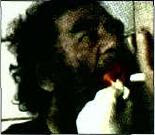


-book stock

In the book “Applied Police and Fire Photography by Raymond P. Siljander, Siljander talks about the Identification Photography, about where the roots of mug shots and identification photography come from and what position they had in the 80s when the book was first published.
In history , law enforcement authorities around the world have searched for a reliable means of identifying criminals. It took until the early 19th century to bring criminal identification to a reliable and scientific level.
Not long after the inception of photography, the police started to use it to take identification photographs of people after they were charged. Commonly, such images are called “mug shots”
Photographs serve a useful purpose in the area of criminal identification, even though they are some well known limitation. Photography was, and still is, simply one of several identification methods.
Even though police took “mug shots” for years, photography was preceded by various other forms of identification methods, with different approaches, depending on time, place, culture and the effectiveness of the method.
It is very interesting to see that some of the oldest methods are still being used today in some form. For example, more then 2000 years ago, the ancient Chinese used finger prints as a approximate form of identification, and finger prints are still used today. Some ancients cultures used methods of scarification while others used tattooing. Siljander says that those methods are also still used today in some places and in some cultures. But the result of scarification and tattooing can be manipulated just as a cattle brand can be altered with a running iron.
Personal descriptions of a person have no doubt been used since the beginning of time. This is still used today even though, like other methods, the accuracy cannot be relied upon.
When photography was effectually developed as a science, police began to use it as a tool for identification purposes. It did not take them long to realise that both a frontal and profile view was the preferred format.
In Siljander's opinion, identification photographs serve a useful purpose and will no doubt continue to be used for a very long time. There will probably never come a time when they are not used, but he says they do have their limitations. It has been said that everone has a double, and it is very true that people can bear a strong resemblance to another person. Another shortcoming is that the appearance of people changes over time, some very significantly. Here is an example of the same person; the second image is taken 22 years after the first one.
The history of identification methods is long and clearly hasn't finished yet. Only time will tell what happens next. “Mug shots” will probably be around for a long time to come.
In my opinion, the book is very good but out of time. Siljander explains the history of mug shots quite simply. The book was published in the 80s and therefore there is nothing about digital photophaphy. Even criminal and identification photography changed technically with the introduction of digital cameras. He talks about the photography as if it were the photography of today, whereas it would be a better description of the photography in the 80s. It is slightly confusing, because there are a few things that have changed over the time.


















